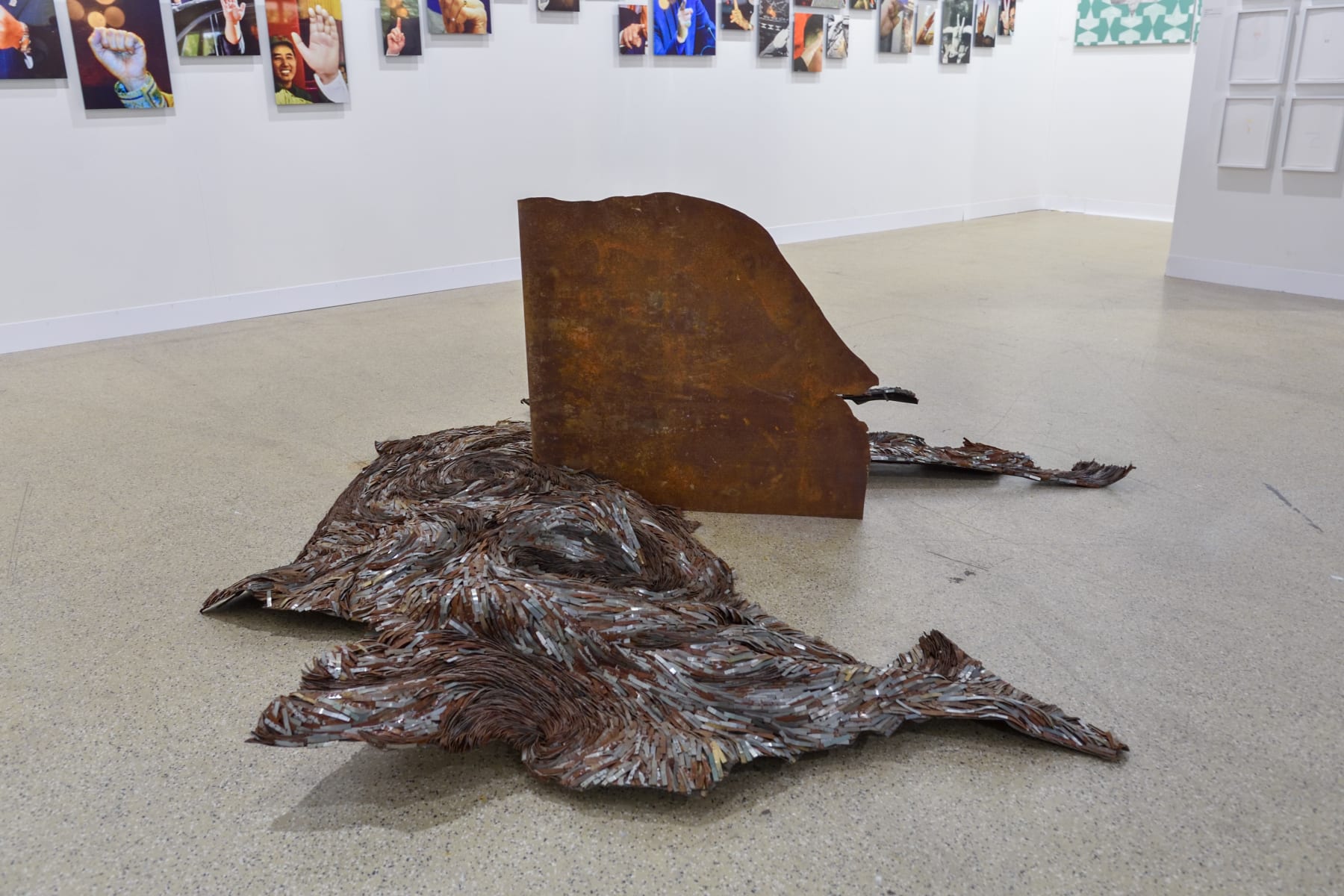Art Basel: Basel
Experimenter presents Transitory Forms, an exhibition of works by Ayesha Sultana, Bani Abidi, Biraaj Dodiya, Praneet Soi, Prabhakar Pachpute, Radhika Khimji, Rathin Barman, Samson Young and Sakshi Gupta at Art Basel 2021. The exhibition approaches the representation of the body as an emotive and political tool through gesture, motif and exploration of material form. Employing an interplay between subversion and abstraction, architectural manifestations, anthropological enquiries and artificial intelligence it points to the human body as a device for building structures of support and resistance.
Ayesha Sultana’s (b. 1984 Jashore, Bangladesh lives and works in Dhaka, Bangladesh) ongoing body of work, Breath Count, are in principle the study of her own breath, through a suite of scratch drawings on clay-coated paper. These are intimate explorations of movement, mark making and corporeality. Repeatedly scratching the surface of the paper, Sultana reveals staccato patterns that represent a delicate inward probe of her own body using count, distance, motion and removal in breath. The Reassuring Hand Gestures of Big Men, Small Men, All Men by Bani Abidi (b. 1971 Karachi, Pakistan, and now working between Berlin and Karachi) is a series of photographs composed of hand gestures of political figures over the last decades. Deeply political and pointedly satirical, Abidi’s work explore the current fractured condition of global politics through the bodily gestures of the hands of its leaders. Biraaj Dodiya’s (b. 1993 Mumbai, India lives and works in Mumbai, India) paintings reveal a layered and complex exploration of space and body. Referring to nightscapes, Dodiya’s works are informed by personal experiences and memories, exploring a moment between the discernible and the obscure. The intensely textured, tactile surface of her work carries a corporeal depth of spatial explorations. Radhika Khimji’s (b. 1979 Muscat, Oman lives and works in London, United Kingdom) paintings and sculptures question how spaces are embodied, how figures are activated in space and explores the relationship between a place and being placed. Human forms, especially the female body in transcendence are clearly discernible in the works on view and seem to suggest directions in how the body may think, feel, navigate the world and negotiate its existence within different dynamics of power. Prabhakar Pachpute’s (b. 1986 Sasti, India lives and works in Pune, India) practice has for over a decade explored forms of resistance and collective action of labour and through his continued engagement with farmers, and miners has used folklore to address contentious issues of land and conflict. Often incorporating lived narratives of farmers and mining workers who have used their own bodies as a last resort to register their protest, Pachpute’s characters are painted against a desolate, surreal and post-apocalyptic landscape, yet always embedded between them markers of resistance and hope. Praneet Soi’s (b. 1971 Kolkata, India lives and works in Amsterdam, Netherlands) paintings made from extended travels in conflict ridden areas uses coded motifs of resistance through his work. He is presenting a painting diptych in silverpoint, informed by his travels his Palestine. Layered beneath the textured surface of the painting, The Bridge and Sebastia, standing forth as a symbol of architecture of resistance, foregrounding the heron, a bird known for its resilience that Soi encountered in Sebastia, Palestine. Rathin Barman’s (b. 1981 lives and works in Kolkata, India) practice uses architecture as an anthropological tool, often mapping human behaviour and architecture together to sculpt in materials of construction, narrating physical adaptations and political ramifications of the built environment. Sakshi Gupta (b. 1979 lives and works in Mumbai, India) and Samson Young (b. 1979 lives and works in Hong Kong) present sculptures that question material in representation. Gupta’s sculpture, I marvel at your forgetfulness points at a mental faculty through a highly textured sculpture using metal scrap and magnets. Young often uses video games as a point of entry into an alternate non-bodily world. Young’s Otocky drawings, are named after a Nintendo game launched in 1987 employs video game’s architecture to explore generative procedures. Alongside a series of 3D printed sculptures that explore the embodiment of AI programming in what Young calls Support Structures.
The exhibition proposes a renewed understanding of the individual and its environment, of body and background, exploring a space between the visible and the concealed.
For any further information or press enquiries email admin@experimenter.in or call on +91.33.4602.6457.




















